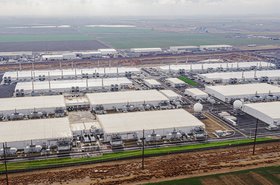Moore’s law. The general consensus is that at the very least it is slowing down, and at worst, it is dead.
So how do we keep advancing in an already technologically advanced industry? It is like the innovators ‘writers block’. Every idea you have feels like it has already been explored and disproven, and progress slows.
But Microsoft argues that this doesn’t have to be the case – we just have to work together.
Instead of gate-keeping ideas and developing technology in secret, we need to swing the doors open and invite the industry in for a brainstorming party.
It is because of this, that Microsoft has been so transparent about their award-winning cloud-production two-phase immersion cooling.
“If the industry is aligned, it actually enables us to scale these technologies in a lower overhead approach compared to sharing less. So it's pretty crucial to collaborate and share across the ecosystem,” said Husam Alissa, director of Advanced Cooling and Performance for Microsoft.
It is for this very reason that the company presented its two-phase immersion cooling at the Open Compute Global Summit.
Christian Belady, Microsoft engineer and vice president said of the summit: “as we start seeing the issues on this planet, it's important for us to think bigger than just our own companies.
“The brilliance of the Open Compute Project (OCP) was to drive more efficiency into the supply chain, and I thought that's brilliant because it allows everyone to start converging on the supply chain, which can drive efficiencies, etc.”
Two-phase immersion cooling is a technology that uses phase change to transfer heat from the chips, explained Husam Alissa.
“Our hardware, our servers, are dunked in a fluid, that's the immersion part. That fluid is designed to have a lower boiling temperature range, and we can adjust the range. The fluid is dielectric and safe, and it's designed to cool electronics.
“As the CPU runs the workload, the cores heat up, and that heat gets transferred to the liquid. The liquid boils and that's the bubble effect that you see. The fluid dries up in the tank and interfaces with a condenser, and it condenses from vapor back to the tank as a liquid. That's the phase change phenomena.
“Now with the chip itself, we like to enhance the boiling that we see. The more boiling we have, we could actually support higher power chips and higher performance at the chip. And there is a kind of a roadmap of how to do this enabling what we refer to as a boil enhancement coating on the chips directly on dyes.”
So why was this necessary? It comes back to Moore’s law.
“We've been noticing a trend of Moore's law slowing, and also of increased power in chips, whether it's a computer chip or an AI chip, to the point where air cooling is becoming limited in what it can do. Some of these AI chips are nearing one kilowatt per chip, and that's a lot for air to manage.”
“We took a step back, and we thought, let's look at this from a system or a system technologist's perspective. We could be solving this problem with liquid cooling, but we were also looking at how that technology would affect our infrastructure. What if we go to a higher density? What would the impact be on the data center footprint, the cost?
“How would that affect us accessing Edge locations and metropolitan areas? Then we also looked at the impact on efficiency and sustainability. How can we lower the power of servers and data centers as we move into technologies like liquid cooling?”
It was these questions that Microsoft set out to answer and successfully did so. But by sharing these findings and their technology, they have also helped build a technological ecosystem, where we can innovate together.




